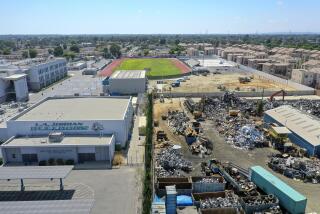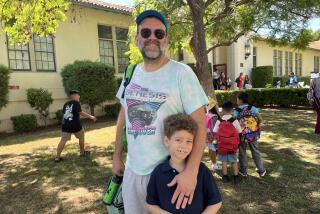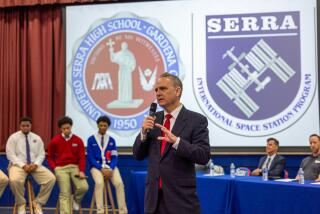Students Talk to Astronauts in Orbiting Space Shuttle Atlantis
Ten-year-old Maureen Teyssier sat cross-legged on the floor with other students at Jerabek School in Scripps Ranch as her teacher and principal tried to quiet the 200 excited children and camcorder-wielding parents who packed the auditorium before dawn Wednesday.
Given the sky-high excitement in the crowd, they seemed to have their work cut out for them.
But Maureen and the others quickly hushed up for the same reason that they had eagerly arrived at school two hours earlier than usual: to hear astronauts on the space shuttle Atlantis talk to them from 185 miles above the Earth via ham radio.
They got their wish at 6:57 as Atlantis pilot Brian Duffy bade good morning to the bleary-eyed gathering and provided static-filled answers to questions about life in space.
The faint connection only lasted about five minutes, but, to the students at Jerabek, the few moments were worth the two months of preparation the event took.
“I am kind of disappointed that we didn’t get to talk to the astronauts longer,” Maureen said, “but I am glad we were chosen to talk to them at all.”
Atlantis astronauts arranged to talk to the students by short wave radio through a program called SAREX--Shuttle Amateur Radio Experiment--designed by NASA and radio associations to help students learn more about life in space, Principal Douglas Hill said.
Seven other schools nationwide--including San Diego’s Challenger Junior High School--were scheduled to participate in the project that connects astronaut to student as the shuttle orbits at 5 miles per second over their region, Hill said.
The mission marks the fifth time SAREX has helped students answer pressing questions on what the Earth looks like from space, what kind of experiments are being researched, and even how astronauts go to the bathroom among the stars, officials said.
But teachers say the project serves an even bigger purpose by getting students interested in subjects such as physics, astronomy, math and writing.
“This is a process where we can do integrated subjects across the curriculum,” said fourth-grade teacher Carla Latimer. “Many students have found a greater appreciation for language skills, technical skills, math, science and geography by working on this project.”
It was through Latimer’s class that the space project came to Jerabek school.
Last summer, Ron Earl, the father of one of Latimer’s students and a ham radio operator, told the teacher about SAREX and urged the class to try to become one of the schools NASA would contact to participate in the project, Hill said.
Earl, Latimer, her students and others wrote letters to the space agency and were accepted in January to be a school involved in the project, Hill said.
At that point, the project really took off.
Earl and others set up two short-wave radios to transmit to the spaceship, connected video and computer equipment to help track the shuttle’s path and erected two large satellite antennas atop the school’s roof to help pick up Atlantis’ signal when the big moment came, Hill said.
Latimer immersed her class in aeronautical studies in preparation for the event and assigned projects that included making T-shirts emblazoned with the shuttle patch and writing biographies on the astronauts, Hill said.
NASA and others donated computer equipment or coordinates that would help trace Atlantis’ path.
Three students were selected by their peers to ask questions, and three representatives from various grades were chosen to attend the communication linkup ceremony, Hill said.
By Wednesday, the school auditorium looked like a mini-mission control as a large video screen in front of the room broadcast colorful computer images of Atlantis as it circled the globe and approached San Diego from the southwest.
Two large short-wave radios with glowing dials dominated the room, and video cables taped to the floor snaked underfoot.
It was only after the final Atlantis signals turned into static that the group admitted the special event was over and reluctantly dispersed to begin another ordinary school day. But to most, Wednesday will never be forgotten.
“This was a once in a lifetime chance,” 9-year-old Jennae Tengberg said. “Not many kids get to talk to astronauts in space.”
More to Read
Sign up for Essential California
The most important California stories and recommendations in your inbox every morning.
You may occasionally receive promotional content from the Los Angeles Times.










